Ever wondered what those adorable little axolotls munch on in the wild? Well, get ready to dive into the fascinating world of their diet.
These aquatic creatures have quite the appetite for meaty treats, gobbling up insects, worms, slugs, snails, and even small crustaceans. They’re like underwater hunters with their rudimentary teeth that allow them to snap down on their prey. But here’s the interesting part: they can’t chew or tear their food! Instead, they open wide and suck in water along with their meal, swallowing it whole.
Now, if you’re thinking of keeping an axolotl as a pet (which I highly recommend because they’re just too cute), you need to know how to replicate their natural diet. Earthworms, daphnia, bloodworms – these live food sources are way more nutritious than boring old pellets or freeze-dried options.
So stick around as we explore everything from hunting techniques to seasonal changes affecting these critters’ meals. Trust me, it’s going to be a wild ride!
Key Takeaways:
- Axolotls in the wild have a varied diet that includes insects, worms, slugs, snails, small crustaceans, crickets, mosquito larvae, small fish, and other small animals.
- They have rudimentary teeth and cannot chew or tear their food, so they swallow it whole.
- In captivity, axolotls should be fed a similar diet to what they eat in the wild, including live food sources like earthworms, daphnia, bloodworms, blackworms, brine shrimp, and tubifex.
- Live food sources are more nutritious than pellets or freeze-dried options, and offering a variety of meat-based foods is important because not all axolotls enjoy the same types of food.
The Diet of Axolotls in the Wild

To ensure the nutritional needs and overall health of axolotls in the wild, it’s important to understand their diet. Axolotls are carnivorous predators. They feed on a variety of animals, including worms, insects, tadpoles, brine shrimp, and small fish. Their diet should consist of live food sources that provide essential nutrients for their growth and development.
By meeting their specific dietary requirements, axolotls can maintain optimal health and thrive in their natural habitat.
According to research by the Amphibian Foundation, axolotls, being carnivorous, enjoy a smorgasbord of aquatic invertebrates, small fish, and even fellow amphibian larvae. An eclectic mix, indeed!
| Primary Food | Frequency of Consumption |
|---|---|
| Aquatic Invertebrates | High |
| Small Fish | Medium |
| Amphibian Larvae | Low |
Nutritional Needs and Health
A balanced diet is the cornerstone of any organism’s health and well-being, and axolotls are no exception. Their diet in the wild is an intricate interplay of nutritional needs and environmental availability, fostering their fascinating physiology and quirky feeding habits.
An axolotl’s diet must be rich in protein, as they are carnivorous creatures by nature. Live foods like earthworms, brine shrimp, and small fishes offer a wellspring of essential nutrients.
Proteins, rich in earthworms and brine shrimp, are essential for tissue repair and growth. They also play a crucial role in enzymatic reactions within the axolotl’s body.
Then, there are vitamins and minerals, essential micronutrients obtained from their diverse diet. For instance, Calcium, abundant in snails, contributes to the robustness of their skeletal structure. A study in the “Journal of Experimental Zoology” underscores the importance of a balanced intake of these nutrients for the axolotl’s overall health.
| Component | Importance | Examples | Frequency |
|---|---|---|---|
| Live Foods | Provide a rich source of protein and essential nutrients | Earthworms, brine shrimp, small fishes | Should form the majority of an Axolotl’s diet |
| Vitamins and Minerals | Essential for overall health and robustness | Obtained from a variety of live foods | Regular part of an Axolotl’s diet |
| Variety | To cater to individual dietary preferences | Invertebrates, snails, small fishes | Mix of different food types should be given regularly |
| Pellets/Frozen Foods | Useful supplement when live foods are not available | Axolotl-specific pellets, frozen brine shrimp | Can be given occasionally but should not replace live foods |
| Size of Prey | Suitable size is crucial for Axolotls to ‘snap and swallow’ | Foods not larger than the space between their eyes | Always consider when feeding Axolotls |
Feeding Behavior of Axolotls
Ever watched an axolotl eat? It’s a sight to behold! Unlike us humans, axolotls lack the ability to chew or tear their food. Instead, they have a fascinating ‘snap and swallow’ technique where they snap down on their prey and gulp it whole. This behavior emphasizes the importance of appropriately sized food items in their diet.
Natural Habitat of Axolotls
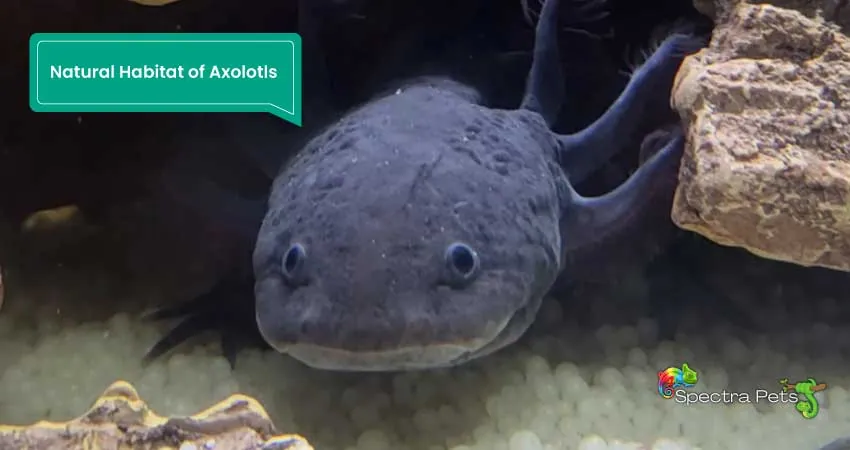
The natural habitat of the axolotl plays a crucial role in determining its diet. The specific environment in which they live influences the availability and types of food sources they have access to.
As a result, the diet of axolotls can vary across different habitats, depending on factors such as water temperature, vegetation, and the presence of other organisms.
Understanding these variations in diet is important for studying their ecological niche and ensuring proper care in captivity.
Role of the Axolotl’s Habitat in Determining Its Diet
In the wild, the axolotl’s habitat plays a crucial role in shaping its diet. Diet adaptations of axolotls are influenced by various environmental factors, including prey availability and foraging behavior.
Axolotls are opportunistic feeders, meaning they will consume whatever food sources are readily accessible to them. Their ability to capture and consume live prey is dependent on the composition of their natural environment.
Environmental factors such as water temperature, water quality, and vegetation cover can impact the abundance and diversity of potential prey items for axolotls. Additionally, nutritional diversity is important for axolotls to obtain all the necessary nutrients for their growth and development.
Therefore, the availability of different types of prey in their habitat directly affects their dietary choices and overall health in the wild.
Diet Variations Across Different Habitats
Across various habitats, axolotls may have different dietary preferences and adaptations based on the availability of prey items and environmental factors. Their diet variations are influenced by their foraging behavior, prey selection, seasonal changes, and the impact of pollution.
Here are some factors that contribute to diet variations in axolotls:
- Prey availability: Axolotls will consume prey that is abundant in their specific habitat.
- Foraging behavior: Axolotls may exhibit different foraging strategies depending on their environment.
- Prey selection: They may selectively choose certain types of prey based on taste or nutritional value.
- Seasonal changes: The availability of certain prey species may vary throughout the year, leading to changes in axolotl diets.
- Impact of pollution: Pollution can affect the abundance and composition of prey species, indirectly influencing the diet of axolotls.
These factors highlight the adaptability of axolotls to different environments and emphasize the importance of understanding their natural habitats when considering their dietary needs.
Main Food Sources: Typical Prey Items for Axolotls
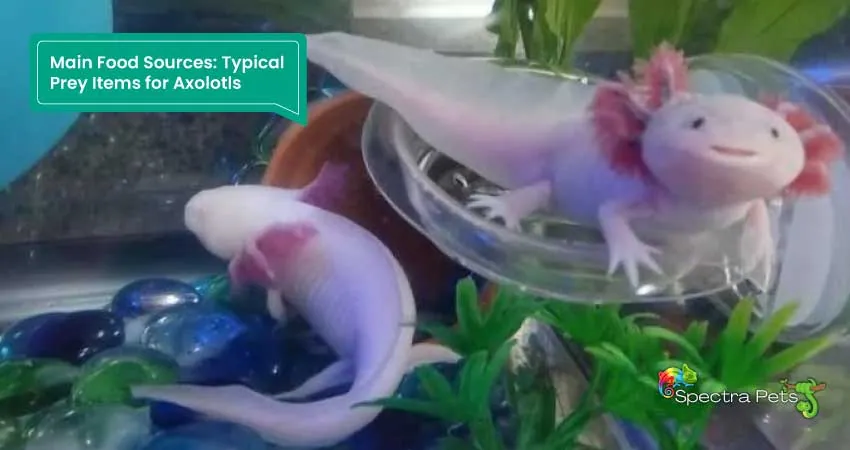
Axolotls feast on a veritable smorgasbord of critters in their natural habitats. Their diets stretch beyond the usual aquatic invertebrates and small fish, revealing a diverse palette befitting these unique creatures.
Aquatic Invertebrates: The Primary Component of an Axolotl’s Diet
Aquatic invertebrates form the cornerstone of the axolotl’s diet. Consider these the axolotls’ go-to grub, a consistent source of nutrition available in ample quantities within their environment.
Different Types of Aquatic Invertebrates Consumed by Axolotls
Axolotls don’t hold back when it comes to the varieties of invertebrates they consume. From Daphnia, or “water fleas,” to arthropods and annelids, axolotls relish a range of invertebrate dishes.
- Daphnia: These water fleas are akin to the axolotl’s favorite snack. Abundant and nutritious, Daphnia forms a substantial part of the axolotl’s diet.
- Mollusks and Insects: Mollusks and insects like chironomid larvae, colloquially known as “bloodworms,” and various crustaceans frequently end up on axolotl’s menu.
- Arthropods and Annelids: These lesser-known critters might not be an axolotl’s top pick, but they do add a touch of variety and additional nutrients to their diet.
Hunting Strategies For Aquatic Invertebrates
Mealtime for axolotls showcases a fascinating mix of skill and strategy. They employ a unique suction mechanism, akin to a built-in vacuum cleaner, swiftly inhaling unsuspecting prey with a quick mouth movement. It’s a spectacle that underscores their predatory efficiency.
Small Fish and Amphibian Larvae: Additional Sources of Nutrition
When the invertebrate population dwindles, axolotls expand their menu to include small fish and amphibian larvae. These secondary food sources ensure that axolotls receive a balanced mix of nutrients, vital for their growth and survival.
As opportunistic predators, axolotls are prepared to pounce on any small fish or tadpole within their reach. Their specialized teeth and suction strategy enable them to snag and swallow their prey whole, contributing to their success in their aquatic ecosystems.
Both small fish and tadpoles are protein-rich, a crucial element for axolotls’ growth and development. By diversifying their diet, axolotls not only ensure optimal nutrition but also help maintain the equilibrium of their habitats.
Worms And Crustaceans
Worms and crustaceans fulfill a significant role in an axolotl’s diet, furnishing essential nutrients crucial for their overall growth and health. Axolotls have specific nutritional needs, and these tiny creatures, teeming with proteins, vitamins, and minerals, meet those dietary requirements effectively.
How Axolotls Hunt And Capture Their Food In The Wild
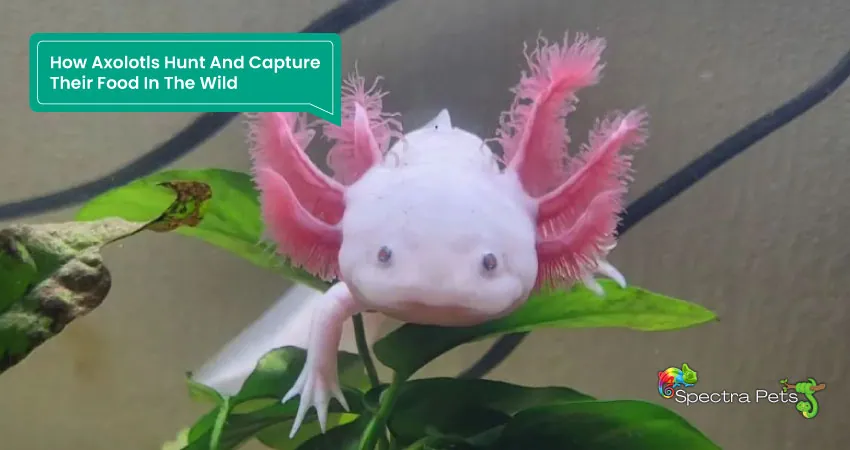
Axolotls employ unique strategies to capture their prey in the wild. With their primitive teeth and wide mouths, they latch onto their prey and rapidly suck it into their mouths, water and all. They have evolved this distinct way of hunting to effectively navigate their dietary habits and natural environment.
Opening their mouths wide, axolotls create a strong suction that pulls in both water and their targeted prey. This specialized method of feeding allows axolotls to swallow their prey whole as they lack the ability to chew or tear food.
The way axolotls hunt does come with certain risks, though. When capturing larger prey, they can become susceptible to predation themselves. Still, these salamanders continue to thrive in the wild, their survival testament to the effectiveness of their hunting strategies throughout their lifespan.
Frequency and Timing of Feeding in the Wild

Wild axolotls exemplify opportunistic feeding behavior, consuming food as per its availability rather than adhering to a specific schedule. The frequency of their meals can fluctuate, influenced by factors such as prey accessibility and their metabolic demands. They may feast multiple times a day when food sources are abundant or go several days, even weeks, without eating during times of scarcity.
Understanding Axolotl Feeding Frequency in the Wild
Axolotls, leading a laid-back lifestyle in the wild, do not follow a strict feeding regimen. Prey availability and metabolic needs shape their feeding patterns, and they demonstrate an impressive ability to sustain extended periods without food. This adaptability permits them to navigate fluctuations in prey availability effectively, consuming any small live creature they encounter opportunistically.
Axolotl Feeding Times: A Matter of Opportunity
In terms of feeding times, axolotls don’t operate on a clock. Instead, they capitalize on opportunities, deploying their keen senses to detect and capture a variety of small prey like insects, worms, slugs, snails, small crustaceans, and even smaller fish. Although the frequency of their meals may vary, axolotls can comfortably endure longer intervals without food, flexibly adjusting their feeding patterns in response to the ebb and flow of prey availability in their habitats.
Comparing the Diets of Wild and Captive Axolotls

Axolotls, whether wild or kept in captivity, are predominantly carnivorous creatures. Their feeding habits differ significantly due to environmental factors and food availability. Here’s an in-depth comparison of their diets, focusing on nutritional value, food sourcing, feeding frequency, and the importance of dietary variety.
| Wild Axolotls | Captive Axolotls | |
|---|---|---|
| Nutritional Value | Their natural diet consists of a variety of small invertebrates, crustaceans, fish, and amphibian larvae, which are rich in essential nutrients. | Standard fare includes specially formulated pellets, and frozen or freeze-dried food options that are often enriched with necessary nutrients. |
| Sourcing Live Food | They are active hunters, preying on small animals like insects, worms, snails, and small crustaceans. | Owners often provide live earthworms (nightcrawlers) which can be sourced from chemical-free gardens or bred at home. |
| Feeding Frequency | They are opportunistic feeders, eating whenever food is available, adapting to the ebb and flow of the food supply in their habitat. | Adult axolotls in captivity are fed 1-2 earthworms every other day, while juveniles require daily feedings due to their faster growth rates. |
| Importance of Variety | In the wild, axolotls enjoy a diverse diet due to the multitude of small animals present in their ecosystem. | Owners are encouraged to provide a range of food to captive axolotls to mimic the dietary diversity they would experience in the wild. |
Nutritional Value
The wild and captive diets of axolotls differ significantly in terms of their nutritional content.
- Wild Axolotls: Their natural diet consists of a variety of small invertebrates, crustaceans, fish, and amphibian larvae. The high-protein content and diversity of these food sources offer a balanced diet, rich in essential nutrients.
- Captive Axolotls: The standard fare for captive axolotls includes specially formulated pellets, and frozen or freeze-dried food options. While these are often enriched with necessary nutrients, they typically don’t match the nutritional value of fresh, live food.
Sourcing Live Food
The way axolotls source their food is influenced by their habitat:
- Wild Axolotls: They are active hunters, preying on whatever small animals they can catch, including insects, worms, snails, and small crustaceans.
- Captive Axolotls: Owners often provide live earthworms (nightcrawlers), a highly nutritious option. These can be sourced from gardens free of chemicals or bred at home.
Feeding Frequency
Feeding frequency is another critical aspect of axolotls’ dietary habits:
- Wild Axolotls: Being opportunistic feeders, they eat whenever food is available, adapting their feeding habits to the ebb and flow of the food supply in their habitat.
- Captive Axolotls: Adult axolotls in captivity are typically fed 1-2 earthworms every other day, while juveniles require daily feedings due to their faster growth rates.
Importance of Variety
Regardless of their habitat, dietary variety is essential for axolotls:
- Wild Axolotls: In the wild, axolotls enjoy a diverse diet thanks to the multitude of small animals present in their ecosystem. This variety ensures they receive a balanced intake of nutrients.
- Captive Axolotls: Owners are encouraged to provide a range of food to captive axolotls to mimic the dietary diversity they’d experience in the wild. This also helps cater to individual food preferences.
While captive diets strive to mimic those in the wild, the nutritional value of live food sources in the wild remains superior. Therefore, sourcing live food carefully and providing a diverse diet are crucial elements for maintaining the health of captive axolotls.
Impact of Seasonal Changes on the Diet of Axolotls
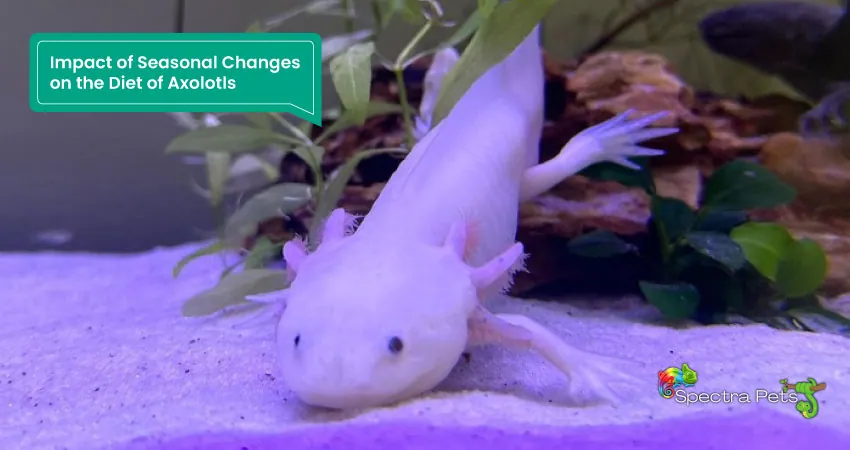
Axolotls, as ectothermic animals, are heavily influenced by seasonal changes, particularly temperature fluctuations. These changes can impact their metabolism, which in turn affects their feeding behavior and diet.
Influence of Seasonal Variations on Prey Availability
Seasonal changes can have a significant effect on the availability of certain prey species. For example, some aquatic invertebrates that axolotls consume may breed more prolifically in certain seasons, leading to an increase in prey availability. Conversely, other food sources may be scarce during colder periods.
Axolotls adapt to these changes by shifting their diet accordingly. They are opportunistic predators and will consume a wide range of prey species available in their habitat. In periods of plenty, axolotls may feed more frequently and grow at a faster rate, while during lean periods, they may slow down their feeding and growth.
Studies have shown that axolotls’ growth rate can vary significantly with seasonal changes. For instance, during warmer months when more food is available, axolotls tend to grow at a faster pace. However, during colder months, their growth rate slows down due to reduced metabolic rates and decreased food availability.
Adaptations of Axolotls to Seasonal Changes in Food Supply
To cope with these seasonal variations in food supply, axolotls have developed several adaptive strategies.
Axolotls have the ability to adjust their metabolic rate based on the ambient temperature and the availability of food. During colder seasons when food is scarce, they can reduce their metabolic rate, which slows down their growth but conserves energy and reduces the need for frequent feeding.
Another remarkable adaptation of axolotls is their ability to store energy in the form of lipids. During periods of abundant food supply, axolotls can accumulate lipids which can be used to fuel metabolism when food is scarce.
So, seasonal changes significantly influence the diet of axolotls. Their ability to adjust their feeding behavior, metabolic rate, and energy storage based on seasonal variations in prey availability plays a critical role in their survival in the wild.
Threats to Axolotl’s Natural Diet
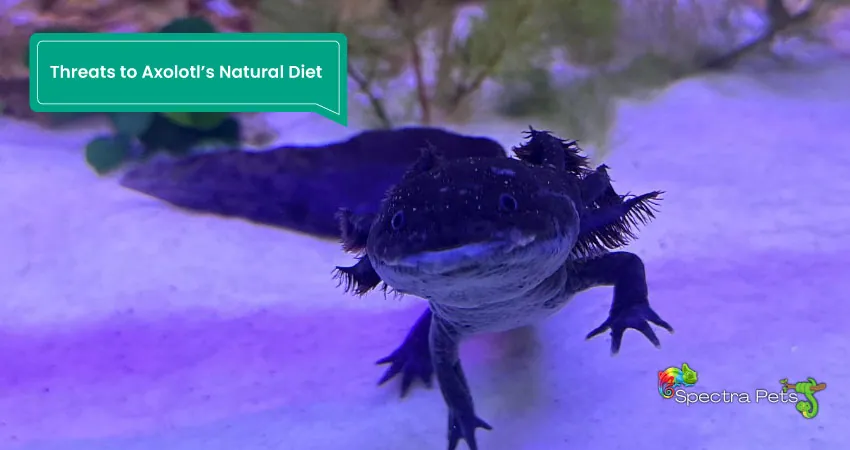
One of the major threats to the natural diet of axolotls is habitat degradation and pollution. As their natural habitats are being destroyed or polluted, axolotls face challenges in finding their preferred food sources.
The impact of pollution on the water quality can disrupt the availability of insects, worms, snails, and other small animals that axolotls rely on for nutrition. Additionally, competition for food resources with invasive species can further hinder their ability to find suitable prey.
Habitat destruction caused by human activities such as urban development and agriculture also limits the availability of food for axolotls. Moreover, climate change effects like changes in water temperature and precipitation patterns can influence the distribution and abundance of their prey species.
Overall, these threats pose significant challenges to maintaining a healthy and diverse diet for axolotls in the wild.
Frequently Asked Questions
Can Axolotls Eat Fruits And Vegetables?
Ironically, axolotls have no nutritional requirement for fruits and vegetables. Their diet should consist of meaty foods like insects, worms, and small crustaceans. Plant-based foods can’t be effectively digested by axolotls due to their digestive system.
Do Axolotls Need To Eat Live Food In Order To Survive?
Live food is important for axolotls’ survival as it provides essential nutrients and mimics their natural diet. However, providing live food can be challenging in captivity. Alternatives like freeze-dried options may lack nutritional value and impact their health and behavior.
Are There Any Specific Types Of Insects That Axolotls Prefer To Eat In The Wild?
Axolotls in the wild have a dietary variety that includes insects. While they do not have specific preferences, they rely on their hunting strategies to capture and consume small insects. This dietary variety is important for meeting their nutritional needs and has an impact on the ecosystem.
How Do Axolotls Find Their Food In Their Natural Habitat?
Axolotls find their food in their natural habitat through their feeding habits and hunting strategies. They rely on their keen sense of smell and vision to locate prey. Their natural diet consists of a variety of meaty foods, including insects, worms, crustaceans, and small fish. Axolotls have adapted by having rudimentary teeth that allow them to snap down on their food and swallow it whole. However, environmental factors can impact the availability of food for axolotls in the wild.
Is It Possible To Overfeed Axolotls In The Wild?
Overfeeding can have negative effects on axolotl health. It can lead to digestive issues, obesity, and poor water quality. Signs of overfeeding include bloating, decreased activity, and excess waste production. Axolotls should be fed in the wild 1-2 earthworms every other day.
Conclusion
In conclusion, understanding the diet of axolotls in the wild is crucial for their overall health and well-being. These fascinating creatures rely on a varied diet consisting of insects, worms, crustaceans, and small animals to meet their nutritional needs.
Interestingly, did you know that live food sources are more nutritious for axolotls compared to pellets or frozen options? This fact emphasizes the importance of providing them with natural prey items in captivity.
By sourcing food from reliable places and maintaining a proper diet, we can contribute to the longevity and vitality of these unique amphibians.

